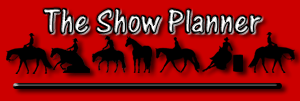FEEDING FOALS
By Eleanor Richards
Copyright @ 2005
Foals are not little horses - they can't be fed as if they were.
Foals, up to 4 months of age, do not have the digestive enzymes or a functioning cecum needed to utilize the nutrients in grains or forage. Foals can eat grain, hay and pasture; but they get very little nutrition from those feed sources.
The enzymes lactase and maltose are predominant in foals up to the age of 3 months. These enzymes digest milk sugars. As the foal ages, other enzymes needed to breakdown carbohydrates become active.
The cecum is part of the large intestine that digests insoluble carbohydrates. There are microbes within the mature cecum that aid the digestion of cellulose and fiber. The cecum is essentially just a fermentation vat, but it is not well developed early in a foal's life.
The most common way a foal gets needed enzymes is by eating an adult horse's manure, called "coprohagia"-from the Greek "kopros" for feces and "phagein" for eating.
Because of the foal's specialized digestive system it is important he receive the proper nutrition. Colostrum and milk from the dam is the best source for this nutrition.
Colostrum is the first "milk" the mare produces. It is high in antibodies that protect the foal from disease. The average foal should receive about 1 cup each hour for the first six hours of life.
It is very important the foal receives colostrum within 12 hours of birth. The foal's small intestine is "open" and allows the large antibody molecules to be absorbed. By the time the foal is 24 hours old the small intestine has changed and the antibodies cannot be utilized.
To insure the foal has received the proper levels of antibodies a serum antibody level (IgG) blood test should be taken at one day of age. This test is very important - especially if the mare was dripping colostrum before foaling. The valuable colostrum may be gone by the time the foal arrives. Some mares may have a poor quality of colostrum.
The colostrum will begin to change to milk within 12-24 hours of birth.
Mare's milk is high in calories, protein, calcium, phosphorus and vitamins. It is not a good source of the trace minerals copper, iron, manganese and zinc. The foal must have these stored in the liver before birth…that is why great nutrition for the mare is very important while she is pregnant. Do not neglect your broodmares!
Foals will start mimicking their mothers and showing interest in solid feed as they age. Each foal is different, so one might start nibbling feed at 2 weeks of age and others earlier or later. At this time a creep feeder can be provided.
Buckeye Nutrition produces one of the best creep feeds on the market. It is called Foal Starter. It is a milk-based pelleted starter feed that will complement the mare's milk.
A creep feeder should be installed for the foal. You do not want the mare eating the foal's feed and you want the foal starter to be available to the foal free-choice. Most commercial feeders have adjustable bars, so the foal's muzzle will fit, but the mare cannot reach the feed.
One note: if you have small foals you may have to make some adjustments. I discovered, while raising Pony Of Americas, my foals could not reach the bottom of the creep feeders. If I made the bars wide enough so the foal could reach the bottom of the feeder the mare could also reach the feed. I ended up putting a block of wood in the feeder, then setting bowl of feed on it. That raised the feed high enough the foal to reach, and I could move the bars close enough to keep the mare out.
At 3 to 4 months the foal can be gradually switched to a good quality feed designed for young growing horses. Then the weaning process can begin…and that is another column!

